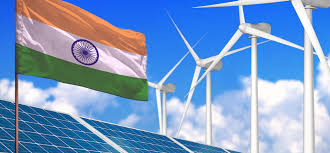India’s first battery storage plant in Chhattisgarh paves the way for green energy
By Simon Stolp & Surbhi Goyal
During India’s long, hot summer afternoons, children used to be fascinated by the ‘magic boxes’ that brought fans back to life whenever the power went out. It was only later that they realized that these magic boxes were nothing more than batteries which stored electricity that turned fans on in a power outage. The drawback was that these boxes were only effective in small areas, like homes.
Then, in 2017, Australia made a major breakthrough. It became the world’s first country to open a big battery storage plant in Hornsdale, southern Australia. The plant stored renewable energy on a much larger scale and fed it to the grid whenever needed. Today, such initiatives are one of the most promising ways for countries to achieve their climate goals.
At the same time as Australia’s groundbreaking initiative, the World Bank began a collaboration with the India’s Solar Energy Corporation of India Limited (SECI) to promote innovative renewable energy solutions that were on the brink of becoming commercially viable.
This led to the establishment of India’s first large scale battery energy storage (BESS) facility set up alongside a 100-megawatt (MW) solar power plant in Rajnandgaon, in India’s eastern state of Chhattisgarh. Although the 40 MW facility, which can store up to three hours of solar power, marks a small beginning, it is a monumental leap forward for India as it is the largest battery storage facility co-located with a solar plant so far.
Being among the first of its kind in India, the project has opened up the market for commercial investments in battery storage facilities. So much so that in the seven years between 2018 and 2025, SECI and other entities issued tenders for BESS operations of a cumulative capacity of approximately 38 GWh – more than 300 times the capacity of the Chhattisgarh facility. And in 2024 alone, there were six times more tenders for battery storage facilities than in the five years before that.

The facility marks a landmark achievement for Chhattisgarh, a state that has long relied on coal to generate electricity. Now, thanks to the facility’s ability to store solar power, the state can use green energy to light up homes, schools, hospitals and businesses even after the sun has gone down.
With renewable energy feeding into its power grid, it is able to supply power at a relatively lower tariff in the evenings when demand for power is at its highest. This also offsets about 170,000 tons of carbon emissions a year, helping the state fulfill its renewable energy obligations.
The pioneering facility completed one year of operation in February 2025. It will continue to run for the next 25 years, providing valuable insights for future efforts in battery storage, and contributing to India’s efforts to install 500 GW of non-fossil fuel energy by 2030.
What made this initiative a success
The facility’s success highlights the critical role of collaboration, innovation, and flexibility in executing such projects in India.
- Regular consultations with stakeholders, including central and state governments and local communities, ensured seamless project development. Close collaboration with authorities secured substantial state support.
- Environmental and Social Considerations: The facility was established on 450 acres of wasteland, with careful attention to environmental and social issues. SECI avoided using land that would restrict communities’ access to natural resources or affect their livelihoods, fostering positive relationships with local communities despite reducing available land.
- Development of Standards: With large Battery Energy Storage System (BESS) projects still at a nascent stage in India, SECI collaborated with manufacturers and testing agencies to establish performance and safety standards, contributing to the development of an ecosystem for such facilities.
- Global Supplier Engagement: SECI conducted three rounds of intense consultations with global suppliers of large batteries to understand the market, ensuring greater competition in the bidding process and participation from reputed players.
- Technical Know-How Acquisition: As this was first project of its kind in India, provisions were made for SECI to acquire technical know-how from the winning bidder, enabling them to learn how to set up such projects and operate and maintain them for the first ten years.
- Performance-linked Payments: To ensure better implementation, payments to suppliers were linked to their performance. Well-defined performance guarantees and clear articulation of key technical requirements played a significant role as well.
- Financial Support and Project Structuring: A grant of $8 million from the Clean Technology Fund (CTF) helped SECI reduce the overall project cost. This, together with efficient project structuring, particularly in optimizing the operations of the facility, resulted in a commercially viable project.
Now, as we think back to the magic boxes of yore, we applaud Chhattisgarh’s groundbreaking initiative which has become a milestone in India’s efforts to adopt cleaner energy. In the years to come, the insights gained from the project will prove invaluable, both in India and internationally.
This article has been republished from The World Bank Blogs.

